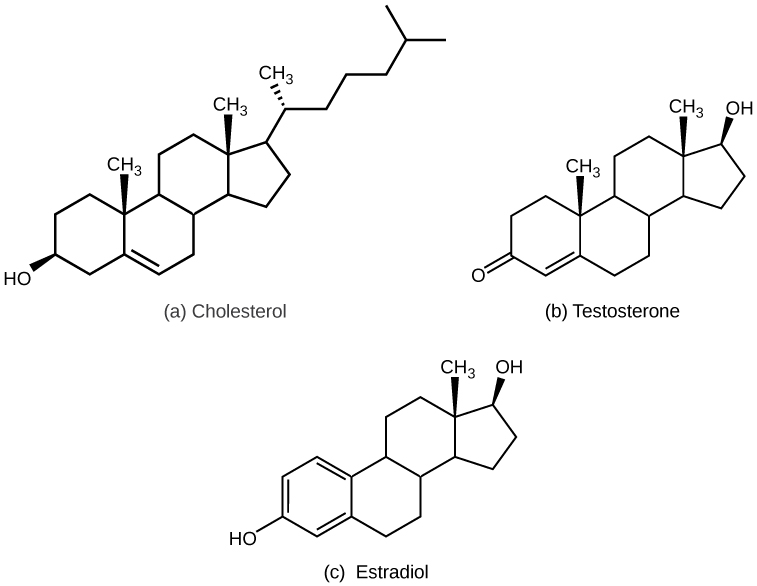3.Human Physiology
3.7 Chemical Coordination
Chemical coordination
Dr V Malathi
The cells, tissues, and organs that secrete hormones make up the endocrine system.
Classes of Hormones
Although there are many different hormones in the human body, they can be divided into three classes based on their chemical structure as
- Lipid-derived hormones : These can diffuse across plasma membranes.Steroid hormones are the main class of lipid hormones in humans. Chemically speaking, these hormones are typically either ketones or alcohols; the last letter in their names will be “-one” for ketones or “-ol” for alcohols. Estradiol, an estrogen and the female sex hormone, and testosterone, an androgen and the male sex hormone, are two examples of steroid hormones. The male and female reproductive systems release these two hormones, respectively. Together with certain other androgens, the adrenal glands also secrete cortisol and aldosterone, which are other steroid hormones. Transport proteins in blood carry steroid hormones, which are soluble in water. They therefore stay in the body longer than peptide hormones. Cortisol, for instance, has a half-life of 60.

“The structures of (a) cholesterol, plus the steroid hormones (b) testosterone and (c) estradiol.” is licensed under CC BY 4.0
- Amino acid-derived hormones : These are water-soluble and insoluble in lipids and hence cannot pass through the plasma membrane. The chemical name of these hormone’s will conclude with “-ine” if it is generated from amino acids. These hormones are derived from the amino acids tyrosine and tryptophan.
- Amino acids derived hormones include
- Thyroxine: produced by the thyroid gland,
- Epinephrine and norepinephrine : made by adrenal gland medulla
- Melatonin : controls sleep cycles and is produced and secreted by the pineal gland in the brain.

“Aminoacid derived hormones” is licensed under CC BY 4.0
- Peptide (peptide and proteins) hormones : These are water-soluble and insoluble in lipids and hence cannot pass through the plasma membrane. These hormones can be either poly peptides or proteins.
- Examples of peptide hormones are oxytocin and antidiuretic hormone ( secreted by the pituitary gland in the brain).
- Examples of protein hormone includes Growth hormones , insulin and follicle-stimulating hormone
Endocrine System
The endocrine system consists of glands that secrete hormones directly into the bloodstream. Major Endocrine Glands and Their functions :
- Hypothalamus:
- Located in the brain, it links the nervous system to the endocrine system via the pituitary gland.
- Produces releasing and inhibiting hormones that control the pituitary gland.
- Pituitary Gland:
- Often called the “master gland” because it controls other endocrine glands.
- Secretes hormones like growth hormone (GH), thyroid-stimulating hormone (TSH), and adrenocorticotropic hormone (ACTH).
- Thyroid Gland:
- Located in the neck, it regulates metabolism through the secretion of thyroid hormones (T3 and T4).
- Adrenal Glands:
- Located above the kidneys, they produce hormones like cortisol (stress response) and aldosterone (regulates salt and water balance).
- Pancreas:
- Produces insulin and glucagon, which regulate blood sugar levels.
- Gonads (Ovaries and Testes):
- Produce sex hormones like estrogen, progesterone, and testosterone, which are crucial for reproductive functions.
Hormonal Functions
- Growth and Development: Hormones like Growth hormone and thyroid hormones are essential for normal growth and development.
- Metabolism: Thyroid hormones regulate metabolic rate, while insulin and glucagon control blood glucose levels.
- Reproduction: Sex hormones regulate reproductive cycles and secondary sexual characteristics.
- Homeostasis: Hormones help maintain internal balance such as blood pressur ,fluid balance and electrolyte levels
Mechanism of Hormone Action
Hormones bind to specific receptors on target cells, triggering a response that can alter cellular activity. This process ensures that the body’s functions are coordinated and regulated efficiently.

